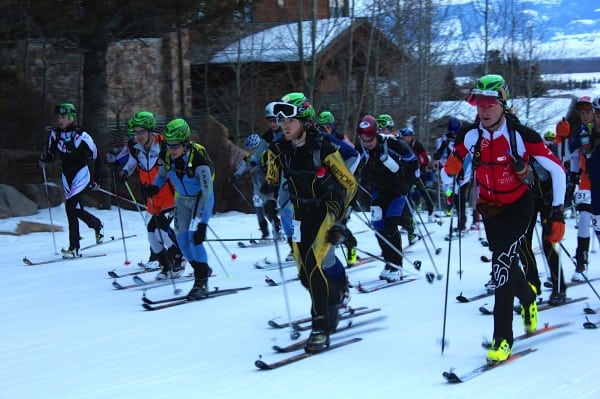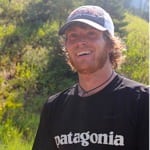For many trail runners the passion for being in the mountains doesn’t end when seasons change. There are plenty of runners who, because of geographic location, can run trails all winter. The trails may not be the beloved high-country singletrack, but they are trails nonetheless. Some trail runners, a less hardy variety, resort to hours of training on treadmills or indoor tracks. For those who live in the high mountains, snowshoes and skis, both downhill and Nordic, replace running shoes, which gives the trail runner a means to visit the familiar paths of summer running.
Where I live in Idaho, the winters are volatile, some come with deep snow and frigid temps, while others are mild and relatively dry. Over the years, I have spent winters skiing, snowboarding, snowshoeing, ice climbing and sometimes trail running. As I have become more passionate about trail running, I looked for a winter sport that more closely mimicked my summertime bipedal recreation. I found ski-mountaineering racing. Well, actually, it found me, but that’s another story.
Regular ski mountaineering, much better known than its racing counterpart, involves climbing snow-covered mountains and skiing back down. It does not require any specific equipment, other than a pair of skis, and is something that comes quite naturally. Case in point, put any typical kid in a park with a snow-covered hill, hand them something to slide on, skis or a sled, and they will spend hours walking up and sliding down. Ski mountaineering takes that same concept and moves it into the same mountains where many of us enjoy trail running. As one gets more involved or vested in the sport, the gear evolves to make travel more efficient.
Ski-mountaineering racing takes ski mountaineering to a different level. I would compare it to trail running versus trail racing. A typical ski-mountaineering race involves several ascents and descents, multiple transitions from hiking to skiing, and in a nutshell are a ton of fun. In the US, most of the races are held at or near ski areas, where course conditions can be slightly more controlled. In an effort to introduce trail runners to the fun that is ski-mountaineering racing, I am going to explain in more depth the gear, training and race prep, and where to go for more information about Skimo racing and races.
Before delving into the details of Skimo it is important to note the amount of crossover that occurs between ski-mountaineering racing and trail/mountain running. The best example of this crossover is Kilian Jornet. He is the current World Ski Mountaineering Champion and has been for several years. He is a dominant force whenever he toes the line in a skimo race, very much like he is when he toes the line in an ultra or any other trail race. Other top Euro crossovers include: Urban Zemmer, world record holder in the Vertical Kilometer, Manfred Reichegger, who has a Wikipedia page listing more than 50 podium finishes in ski mountaineering and sky running; the young and talented Salomon runner Philipp Reiter is great young mountain runner and ski mountaineer with many top ten finishes internationally; and a whole host of other incredible mountain athletes. The support is as equally well represented on the ladies’ side with the likes of Mireia Miro, Laetitia Roux, and Maude Mathys, the top three ranked females in the world are also top level trail runners. I would dare say that nearly all of the top ski-mountaineering racers in Europe also tend to be top sky runners as well.
In the US there has recently been interest expressed by a handful of top mountain runners including Mike Foote and Max King. We have yet to see them toe the line, but I don’t doubt we will see them in the near future. Nikki Kimball has been seen at many ski-mountaineering races in the last couple of years and is becoming quite the competitor, as well. It would be a travesty to not mention the Dorais brothers, both have impressive running resumes to go along with their top skimo finishes. On the ladies’ side, Stevie Kremer is crushing nearly every trail race she enters and finished many times on the podium for skimo last season. Sari Anderson, Jari Kirkland and Nina Silitch, all US ski mountaineering team members compete just as well on snow as they do singletrack. While ski mountaineering seems to be going through a coming-of-age time in the US, I think we will continue to see more crossover between the two sports as they do compliment each other so well.
Equipment
As with most sports, trail running included, the equipment used during racing tends to be the lightest and most advanced available. Skimo racing is no exception. The equipment has evolved over the last several years to be very light and utilitarian. It has progressed to the point that the International Ski Mountaineering Federation established rules about the equipment and other mandatory gear. The ISMF regs require that skis be at least 160cm and combined with bindings must weigh at least 750 grams (1,500 per pair) for men and 700 grams (1,400 per pair) for women and junior racers. The boots also have a minimum weight of 500 grams (1,000 per pair) for the men and 450 (900) for the women and junior racers. All of this equipment must be in an unaltered state from the manufacturer. It may seem silly to have minimum weights for equipment, but it is for racer safety and to put in perspective the weights of the Skimo skis/boots/bindings is 1,250 grams per foot or 2.75 pounds, for those metrically disadvantaged folks, which compares to about 340 grams or .75 pounds for a trail shoe. If comparing the boots alone, they tend to be about 150 grams heavier than a trail shoe, which is only about 5 ounces difference. The binding for Skimo racing is designed to lock the heel down for descending and allow it to be free while ascending. The motion for ascending is very similar to running, so similar in fact that in Europe it is commonly referred to as ski running.
Another critical part of the gear for Skimo racing is the climbing skin. The skins attach to the bottom of the ski for ascending. They are made with a long fiber that is laid unidirectionally on one side and a sticky “glue” on the other. The glue sticks to the base of the ski, and the fibers are in contact with the snow. Because of the unidirectional fibers, the skin slides forward with minimal resistance and then grabs when weighted allowing the skier to slide uphill. Once at the top, the skin is removed, heel of the boot locked into place and the racer can then ski down.
The final portion of Skimo gear is the mandatory equipment. This list of gear varies some from race to race, but always includes a helmet, a backpack that can hold skis, an avalanche transceiver, a probe, a shovel, and a wind layer. Additional gear that may be required could include a climbing harness, crampons, additional warm layers, and a Via-Ferrata kit, this gear would be required depending on course conditions or how technical the course is.
Training
Training for ski-mountaineering racing is very similar to training for mountain running. Most racers spend quite a lot of time trail running in the summer and then transition to ski mountaineering once snow covers the trails. It is becoming popular to mix in roller skiing a couple of days a week as the racing season approaches, but when there might not be enough snow to ski. Personally, I mount a pair of classic roller skis with a tech binding so I can start training in my race boots quite some time before the snow flies.
There are lots of theories on how to train for ski-mountaineering racing, just like there are for trail running. Generally, it is good idea to include tempo workouts, intervals, hill repeats, long aerobic workouts and, of course, skiing powder into the mix. For me, a typical week would go something like this: Monday – tempo, Tuesday – easy recovery, Wednesday – intervals (or hill repeats), Thursdays – easy recovery, Fridays – longer threshold workouts, Saturdays – long aerobic, Sundays – rest day. The previous is just a template, but it seems to work well for me both for Skimo and trail running.
Race Prep
Getting ready for a Skimo race takes more than just getting the gear and training. There is quite a lot of technique involved, that if practiced can make you much more competitive on race day. One of the most important technical aspects of Skimo racing is the transition. I mentioned before that you will transition multiple times during a race. Sometimes from skiing to skinning, others the reverse. You will also have to transition from skiing or skinning to skis on pack, boot-packing mode, at least once during a race. If you are willing to spend a little bit of time mastering these transitions before race day, you will be able to quickly move yourself up the ranks. Uphill-skinning technique is another area that if you spend some time working on, you will find yourself moving much faster with less effort. Included in uphill skinning is the dreaded kick turn. Interestingly, in the US we tend to have less of these in our races because many lack the technique to move through them quickly, including course setters. In Europe, on the other hand, you may find yourself doing kick turns until the cows come home. There are lots of good resources on the web, including video tutorials that can help you improve your technique.
Resources
Okay, now that you’ve read up to this point and you are just chomping at the bit to get out and start training for your first Skimo race, where do you look for info? The first place to look is the United States Ski Mountaineering Association (USSMA) website, USSMA.org. There you can find video tutorials on technique, a full schedule of all the US races, gear reviews and suggestions, and many other helpful links. Skitrack.com is another very useful site, put together by a member of the Canadian national team that has things like gear-weight comparisons, trip reports and a schedule of all things racing north of the border. Internationally, the International Ski Mountaineering Federation (ISMF) website can be very helpful, ISMF-ski.org. That is the place to go for an international, including World Cup and World Championships, schedule, as well as more info on gear, technique, anti-doping, and much more. If those sites don’t answer all of your questions you can always fire up the Google machine and the answers will be just a few keystrokes away.
Call for Comments (from Bryon)
- Have you ever tried ski mountaineering? If so, what’d you think?
- If you’ve never tried skimo, do you think that you will?
- What do you think of the complimentary nature and crossover between trail running and ski mountaineering?





